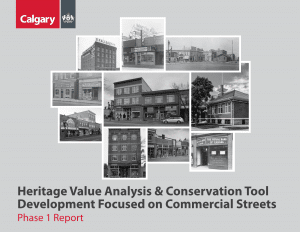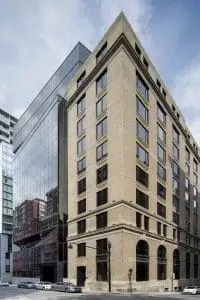- May 17, 2023
Heritage conservation not only creates value in our cities but shares its wealth, too.
For centuries, heritage architecture conservation has been recognized by many as beneficial. From how they were designed to the materials they’re made of and the stories they tell, the structures we call heritage today embody the past and teach us about the ways of life of the people who inhabited them. When cared for, they act as heirlooms and antiques we pass down to the next generation.
There is rarity and value in the things we have that withstand time while speaking of history, speaking authentically of the technology and craft of the time it came from. These facets help explain why heritage conservationists have long felt an innate sense that there is value in heritage buildings, but studies that quantify their monetary value are far and few between.
While we can believe that conserving architecture matters because it can revitalize communities, help with business development, and create a greater sense of place, the cost of conserving heritage can often lead to questions around whether or not the cost of it is worth doing—as it turns out, arguments in favor of conservation can not only be made stronger by looking at dollars and cents, but also at how heritage benefits our lives and the planet as well.
What is the value of conserving heritage architecture?
That question led the City of Calgary, a place rich with heritage structures dating back more than a century, to conduct a study with a team composed of specialists from Lemay and other consultants: What is the value of heritage conservation in terms of their economic, social, and environmental benefits?
Focusing on four heritage areas where there is a concentration of heritage buildings as well as four non-heritage areas in Calgary, the assessed value or recent sale value was collected, assessed, and compared.
 Titled Heritage Value Analysis & Conservation Tool Development Focused on Commercial Streets, the results were surprising: not only was the overall value of these heritage areas combined over 30% higher because of their heritage character and quality, an effect called the heritage premium, but heritage buildings also had a residual effect on the buildings around them whether they were heritage or new buildings—a ’heritage halo’ which benefitted places nearby with increased economic value.
Titled Heritage Value Analysis & Conservation Tool Development Focused on Commercial Streets, the results were surprising: not only was the overall value of these heritage areas combined over 30% higher because of their heritage character and quality, an effect called the heritage premium, but heritage buildings also had a residual effect on the buildings around them whether they were heritage or new buildings—a ’heritage halo’ which benefitted places nearby with increased economic value.
“We were all a little bit nervous as to what the outcome was going to be, but it was a significant value, explains Mark Chambers, Director of Conservation Architecture at Lemay. “This isn’t specific to Calgary, either; it can apply to any jurisdiction that has a concentration of heritage buildings.”
In addition to this, heritage areas have been found to attract creative class and knowledge sector businesses and were shown to have 1.5 times more jobs per acre; beyond the economic value, 3 out of 5 Calgarians said they were willing to pay as much as $60 per person to maintain those heritage areas which could amount to as much as $80 million. There was an environmental value as well, as keeping them intact and up to code avoided the cost of millions of dollars in releasing embodied energy and carbon, in addition to offsetting the cost of filling landfills with the waste of demolition.
Together, this triple bottom line of benefits shows how the value of heritage buildings is not only financially valuable, but socially and environmentally valuable as well, providing profits while paying dividends to people and to the planet.
Oftentimes, buildings must be officially designated as heritage to be deemed worthy of conservation, rehabilitation, and repurposing, but heritage premiums and heritage halos show that there’s a viability to the costs behind updating old building stock.
“To date, there hasn’t been much incentive for owners or stakeholders to factor in the true cost of buildings, and these findings show there’s an interesting shift happen around understanding the embodied value of heritage,” explains Grace Coulter Sherlock, architect and Lemay’s Regional Director in Western Canada. “Without incentives like this, tearing down buildings and building something new can be seen as the easier path.”
The new lives of buildings that give back
As cities grapple with questions of how to revive the economic activity of their downtown cores and attract people from around the world, heritage districts present an intriguing proposition: Lean into the old and be open to the value of history before opting to demolish and build something entirely new in its place.
This is because heritage architecture conservation isn’t restricted to buildings that are upwards of a century old. Cities are full of modern heritage structures dating back anywhere from the 1950’s to the 1970’s, and they can take on a new life of their own through rehabilitations, modernizations, upgrades, and repurposing.
With heritage conservation, we also have an opportunity to intervene on past mistakes of structures and make them more inclusive than they once were. Interventions can account for anything from greater accessibility for physical and mental challenges to redesigning buildings with colonial pasts so they can invite in once neglected communities, to reconnecting them with nature with design details like operable windows, access to sunlight and natural ventilation, and passive heating and cooling strategies that are typical that of heritage buildings dating up to the 1940s in Canada.
An evolution of design through time
While it can be inspiring to see a building serve the same purpose it did for over a hundred years like banks and city halls, an important thing worth noting about heritage conservation is that it doesn’t mean the original purpose of the building has to be maintained so long as it is respectful of its original architectural, cultural, and contextual significance and its redesign continues that respect.
Above all, heritage conservation there are lines that must not be crossed: Any intervention should be removable without having damaged the original heritage fabric, and must be compatible with, distinguishable from, and subordinate to the original building.
 Provided that respect is in place, buildings can evolve and be reimagined in a myriad of ways, where thoughtful interventions that recycle and upcycle buildings can create entirely new spaces with new purposes while continuing to tell an original story. With Calgary’s Centennial Planetarium, for example, the original building’s integrity was maintained, but its design and spatial qualities allowed for a new and compatible use as a sweeping public art gallery. Montreal’s 425 Viger West is another example, becoming the site of an office for Google. Even as some buildings’ cultural significance and original purpose change over time like we’ve seen with churches, the memory, meaning, and energy can be conserved and harnessed with entirely new identities by design.
Provided that respect is in place, buildings can evolve and be reimagined in a myriad of ways, where thoughtful interventions that recycle and upcycle buildings can create entirely new spaces with new purposes while continuing to tell an original story. With Calgary’s Centennial Planetarium, for example, the original building’s integrity was maintained, but its design and spatial qualities allowed for a new and compatible use as a sweeping public art gallery. Montreal’s 425 Viger West is another example, becoming the site of an office for Google. Even as some buildings’ cultural significance and original purpose change over time like we’ve seen with churches, the memory, meaning, and energy can be conserved and harnessed with entirely new identities by design.
“Buildings are not stagnant. They never were and they never will be,” says Mark Chambers. “There is an evolution to them, from the first designers to the ones who rehabilitate and adaptively reuse them.”
Even as heritage districts can physically change and have tenants that are leagues apart from their predecessors, they form an important core for the cities they’re in; whichever city people travel to, they congregate in the old quarter, as it attracts both interesting and engaging businesses as well as schools, theatres, and museums. They are small scale places of cultural cohesion, walkability, and social engagement.
“As we visit and often live in cities, we intuitively know that heritage districts are the most attractive, but it can be hard for building owners or municipalities to identify and quantify the monetary value of heritage, beyond feeling that value,” Grace Coulter Sherlock adds.
“That’s where the innovation of the heritage study comes in, because it levels out the conversation and becomes something that everyone, instead of relying on gut instinct, can get a common understanding of the value of heritage.”
Through design, we’ve uncovered ways for buildings to give back and to live well beyond their original purpose—here’s what you need to know about conservation architecture and why it matters.